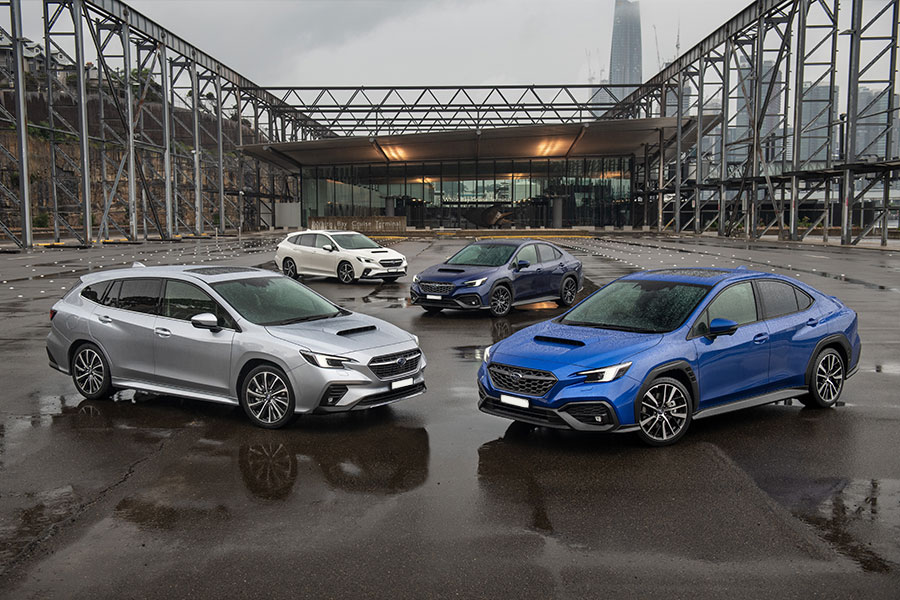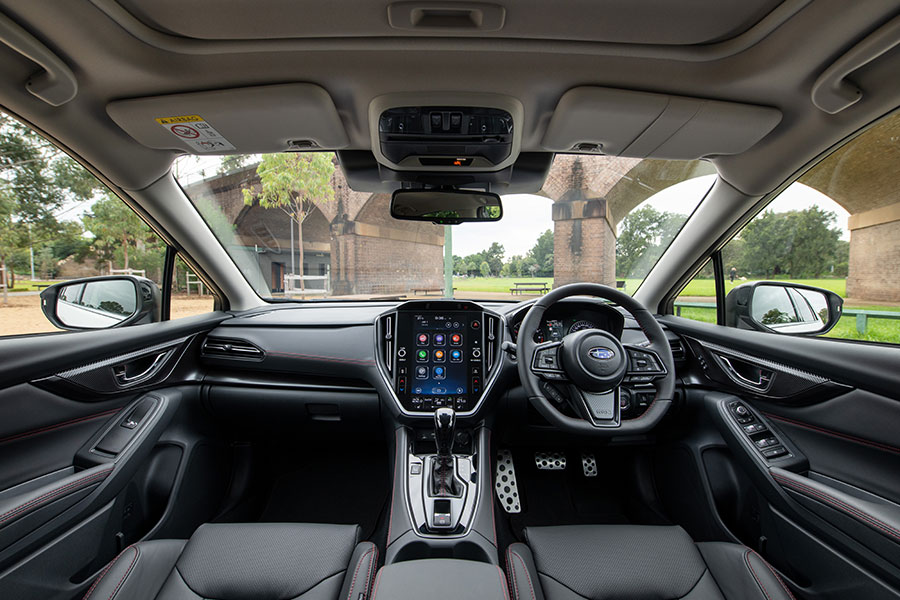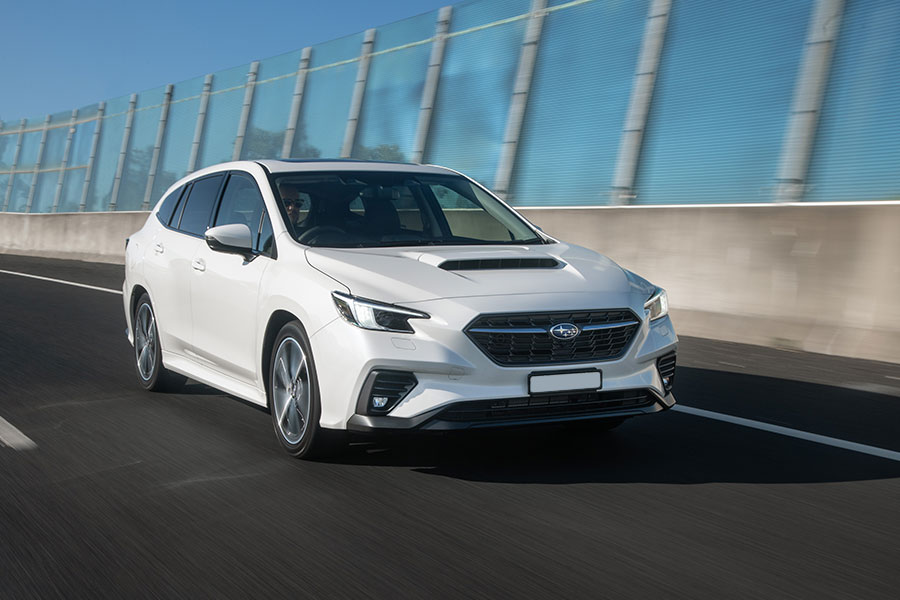Whether you’re ready to get started or would like to know more, we’re here to help.
By Fean Torr, carsales.com.au
The original Subaru WRX was the poster child for pocket rocket performance. Its rally-bred roots linked turbo charged power with all-wheel drive traction into an affordable, four-door sedan for the first time, creating an instant cult classic from the moment it launched in 1992.
The ‘Rex’ lost some of its no-frills, all-thrills character as it matured over the years. And that evolution has continued with the fifth-generation 2022 Subaru WRX that touched down in Australia earlier this year, bringing with it a dynamic new design and a bigger 2.4-litre turbo-petrol engine.
Prices have gone up and the wings have come down, and buyers can choose from either a sedan or a wagon body style again.

So, is there still a cheeky, playful inner child in the WRX, or has it become something completely different? Let’s find out…
Some tea, Rex?
First things first, the 2022 Subaru WRX still delivers a white-knuckle driving experience.
After an eight-year gestation, and the promise that Subaru would further redefine the WRX as a standalone model with this fifth generation, there was much anticipation and even a bit of trepidation ahead of its arrival. And after driving it on the road, the racetrack and on the dirt it’s fair to say it won’t disappoint rusted-on fans.
The WRX was born into rallying (its badge is an acronym for World Rally Xperimental) and its combination of a turbo charged engine and an all-wheel drive transmission were critical to its success on the world stage – both in sport and showroom sales. It was the OG giant killer.
Nothing has changed in that regard with the latest ‘Rex’; its turbo engine spins eagerly into the upper reaches of the tacho and the all-paw traction helps it blast out of corners with impressive resolve.
But these experiences are not unique to the WRX anymore.
They used to be, back in the early 1990s. But the fifth-generation Subaru WRX doesn’t break any new ground.
Instead, it continues to mature into a well-rounded and more versatile model that’s lost some of its raw edge.
Sure, it looks fresher and sharper in its exterior design and, yes, it is still fast, engaging and fun to drive. But it’s nowhere near as exciting as Subaru hinted it could be with the jaw-dropping Viziv Performance concept that previewed the WRX back in 2017.
In fact, there are several elements that feel like a step backwards, which we’ll get into later. First, the numbers and the details…
A little more, Rex
The new 2022 Subaru WRX is available in a wider range of models than before with both sedan and wagon body styles across eight individual variants.

The entry price has increased by $4000 over the outgoing version with the basic manual-gearboxed sedan costing from $44,990 plus on-road costs.
If you don’t like changing gears, buyers can choose the optional Continuously Variable Transmission (CVT), which has eight pre-programmed ‘stepped’ ratios, for an additional $4000.
It should be noted that the WRX’s closest performance sedan rival in this bracket, the Hyundai i30 N sedan (from $49,000), doesn’t charge extra for its dual-clutch automatic transmission.
WRX manual models also miss out on some key safety features, which we will explain more about later.
The WRX Sportswagon (as Subaru calls it) is exclusively available with the CVT auto and commands a $1000 premium for its added boot space, taking the starting price to $49,990 (plus ORCs).
Both body styles are available in three trim levels, starting with the entry-level, eponymous WRX and topping out with high-grade tS models. But each has a unique mid-tier version; RS in the sedan and GT in the wagon.

All models come with a decent list of standard equipment, including a striking new vertically-aligned 11.6-inch touch-screen, dual-zone automatic climate control, impressively supportive sports seats, automatic LED headlights and tail-lights, rain-sensing wipers and keyless entry/engine start.
The mid-spec RS sedan (from $50,490 plus ORCs) and GT Sportswagon (from $55,490 plus ORCs) models add a powered sunroof, premium trim, upgraded front seats with power adjustment and heating, a Harman Kardon stereo and more.
Range-topping tS models, which are now more expensive than the previous-generation Subaru WRX STI and start at $56,990 (plus ORCs), are only offered with the automatic transmission but add configurable drive modes to tailor the steering and power levels, along with adjustable suspension settings via adaptive dampers.
There are nine exterior colours available, including the iconic WR Pearl Blue, along with several new shades such as Solar Orange Pearl, Ignition Red, Sapphire Blue Pearl and Ceramic White. Greys and blacks round out the rest of the paint choices.
While the level of standard equipment is pretty decent, there are some notable omissions for a car at this price, such as 19-inch alloy wheels, ventilated seats, a digital driver’s display and how about some USB-C ports or a wireless phone charger?
Even some of the switchgear feels a bit outdated which makes the car feels more like a 2016 model and not a cutting-edge, brand-spanking new vehicle from 2022.
Aftersales support is on par with most rivals, starting with a five-year/unlimited-kilometre vehicle warranty, backed by five years of capped-price servicing.
Service intervals are pegged at 12 months or 15,000km, whichever occurs first, with automatic WRXs costing an average of $473 per service, or $2365 across five years.
Surprisingly, the manual is a bit more expensive to service, costing $486 per annum or $2433 over five years.
No sugar, Rex?
Subaru has a solid reputation for safety, but the 2022 Subaru WRX is unlikely to gain a five-star ANCAP rating across the entire range because manual models miss out on several key features that are mandatory for a top score.
While all models come equipped with blind spot monitoring, lane change warning, rear cross traffic alert and eight airbags, WRX sedans with a manual transmission miss out on autonomous emergency braking (AEB), adaptive cruise control, a lane centring function, an intelligent speed limiter and speed sign recognition.
These features are, however, standard on all CVT automatic-equipped WRX models, which Subaru claims will account for 60 percent of sales.
The same issue affects manual versions of the new Subaru BRZ coupe, which is perhaps why the WRX Sportswagon, with an automatic transmission and all the safety kit, is being pitched at family buyers.
So, you’re a boxer, Rex…
One of the WRX’s signature elements has always been its horizontally opposed (aka boxer) turbo-charged four-cylinder engine that ensures a symmetrical layout and lower centre of gravity for optimal handling. Not to mention its unique exhaust note.
That doesn’t change with the new 2022 Subaru WRX and the turbocharger is still fed by a top-mounted intercooler that gulps fresh air via the WRX’s trademark bonnet scoop.
Together with its permanent all-wheel drive system, the turbo-boxer engine gives the WRX an appealing point of difference to rivals such as the Volkswagen Golf GTI, Hyundai i30 N and most other hot fours that favour inline engine configurations.
But bucking the trend to downsize internal combustion engines and improve fuel consumption, Subaru has given the WRX’s motor a bump, increasing its capacity from 2.0 litres to 2.4 litres. Naturally, its outputs are increased to 202kW at 5600rpm and 350Nm from 2000-5200rpm.
That compares to the outgoing model’s 197kW at 5600rpm and 350Nm at 2400-5200rpm.
So, for 20 percent more engine, you only get an extra 5kW and the same peak torque across a slighter broader spread? Sounds like a raw deal to me.
But Subaru explains that the new twin scroll turbo charger only produces a maximum 12PSI of boost pressure, which is down by almost half compared to its predecessor, even though it is fed by a larger intercooler derived from the previous WRX STI.
Still, figures like 202kW and 350Nm are not to be sniffed at and positions the WRX on par with its rivals.
Even though there’s no launch control system, the all-paw traction ensures it still pulls hard from standstill. Based on our testing, the claimed 6.0-second 0-100km/h sprint for the six-speed manual is almost spot on.
The TY75 six-speed manual carries over from the previous WRX, and while shifts feel decisive and secure for the most part, it is not as crisp as a Honda Civic Type R or a Nissan 370Z.
A viscous-coupled mechanical limited-slip centre diff nominally apportions torque 50:50 front to rear for manual models.
Where the manual is fast and resolute off the line, the automatic WRX is more lethargic from a standing start and makes us question Subaru’s claim that it is only 0.1sec slower to triple figures.
The car maker says its new ‘Subaru Performance Transmission’ automatic is a huge improvement over its predecessor with 30 percent faster upshifts and 50 percent faster downshifts. It certainly feels more engaging when using the steering wheel paddle shifters than any other CVT, but it doesn’t offer the same connection as the manual – or even a conventional auto for that matter.
Auto WRXs also have a slightly different default torque split to manual versions, with 45:55 front/rear, but it doesn’t really manifest in any meaningful way, and there’s no sense of the back end skipping out.
The WRX accepts only premium petrol, 95 octane or above, with manual models chugging a claimed average of 9.9L/100km, whereas the automatic is more economical 8.5L/100km.
During our test period, we managed 11.5L/100km with the manual and 11.2L/100km with the auto, blending hard and fast driving with big chunks of freeway cruising.
From wild to mild
There’s an aura of nostalgia that swirls around the 2022 Subaru WRX. And I won’t lie, it does feel pretty special sliding into the heavily bolstered driver’s seat and looking out over the big bonnet scoop, which is an ever-present reminder of its raison d’etre.
Part of me absolutely loved the two days behind the wheel of the WRX during the national media launch, where we experienced it on road, track and gravel. But I can also attribute that to being a WRX fan who witnessed the original car blaze a trail back in 1992 when I was just 11 years old…
If you leave emotion out of the equation, however, and look at the latest WRX objectively it doesn’t quite stand up to the competition as well it once did.

Yes, the new platform and body shell are stiffer – with 28 percent more torsional rigidity – which, together with a revised suspension tune, improves the WRX’s handling to the point where it feels slightly sharper on initial turn-in and remains remarkably flat through corners.
Indeed, the overall dynamics are good and the car is very satisfying to drive hard, but it doesn’t deliver anything new that would give owners of the previous WRX a sense of FOMO.
Don’t get me wrong; the WRX manual sedan is still a rapid point-to-point machine on any road and it’s capable and determined on the racetrack but where it really comes alive is on dirt roads, scrapping its way along deserted forestry tracks with more pluck than a featherless duck. But that’s not for everyone...
Despite the larger engine, it doesn’t feel as powerful as many of its rivals, namely the Hyundai i30 N sedan, there’s no dual-clutch automatic transmission with tricky launch control and multi-mode driving functions and, worse than anything, Subaru has completely extinguished the car’s unique exhaust note.
Enthusiastic drivers will still find joy in punting the WRX sedan, but the automatic dilutes the experience. And the wagon feels like a completely different beast, because in some ways it is.
In other markets, the 2022 Subaru WRX Sportswagon is known as the Levorg, which was previously sold here, and features a narrower body with a smaller 1.8-litre turbo motor.
But Subaru Australia has uniquely positioned it within the WRX family and requested that local models have the 2.4-litre engine.
But it doesn’t have all same bits as the sedan. It still carries skinner tyres (225/45 Yokohama BluEarth GT AE51s compared to the sedan’s 245/40 Dunlop SP Sportmaxx GTs) and a different suspension tune which reduce its dynamic bandwidth.
Top-spec WRX Sportswagon tS models pick-up adaptive dampers which deliver more front-end confidence when set to Sport+ mode, but it’s still not a match for the basic suspension set-up in the sedan.
Maybe more should have been done to better tune the chassis to the engine’s higher outputs?
Consequently, the softer suspension does make the Sportswagon a better car to live with around town.
Whichever body style you choose, there’s more room in the Subaru WRX now with good passenger space up front and reasonable room for two adults in the back seat, if a little light on for legroom.
Boot space is pretty good for a small car at 411 litres in the sedan, while the wagon offers up 492 litres, expanding to 909 litres with the rear seat folded.
Indeed, the WRX has matured significantly and is now a mild-mannered vehicle whose raw and visceral attitude has been dialled back to appeal to a wider range of customers.
So, the time has come
The fifth-generation 2022 Subaru WRX still carries the DNA of its predecessors, but its character has been further diluted with this new model.
While that could be seen as a backward step to those that appreciated its no-frills charm, it could also make the WRX more appealing to a broader audience.
You only have to look at the model range to see that just two of the eight WRX variants are offered with a manual transmission, which shows where the car is going and what Subaru believes the majority of customers are looking for.
Mission accomplished, then? For Subaru’s accountants, yes. For purists, no way Jose.
The small-car performance segment has metabolised at a rapid rate in recent years, evidenced by exciting new vehicles from Hyundai N and Toyota GR, yet the WRX seems to be evolving at a slower pace.
Yes, the fifth-generation WRX is a better car than its predecessor in many ways, but at the same time it no longer feels like the giant-killing, bargain-priced pocket rocket it once was.
How much does the 2022 Subaru WRX RS cost?
| Price: $50,490 (plus on-road costs) |
Transmission: Six-speed manual |
| Available: Now |
Fuel: 9.9L/100km (ADR Combined) |
| Engine: 2.4-litre four-cylinder turbo-petrol |
CO2: 225g/km (ADR Combined) |
| Output: 202kW/350Nm |
Safety rating: Not tested |
Disclaimer: Images supplied by Subaru Australia.
This article was prepared by an independent author. The information contained in this article represents the views and opinions of the original author, and is based on research carried out by the original author. The appearance of the article on Maxxia's website does not constitute an endorsement of its content by Maxxia in any way. The article has been made available for informational purposes only and should not be taken as advice. While all reasonable care has been taken to ensure that the statements made by the original author in the article are fair and accurate, Maxxia does not guarantee or warrant the accuracy or completeness of this information and will not be liable for, or in connection with, any loss or damage suffered as a result of any inaccuracies, errors or omissions or your reliance on this information. You should independently research and verify information before making any decision in respect of a vehicle.



